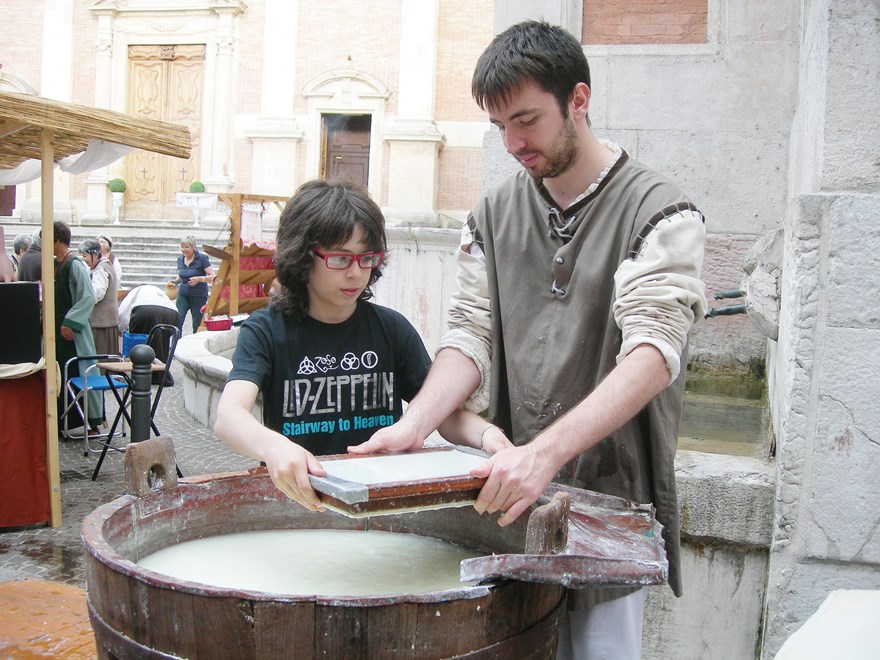Master Italian papermaker Lorenzo Santoni presents a medieval, handmade paper demonstration during the Harmony Arts Festival Aug. 11, 3-5 p.m. at Ambleside Landing. Free. More info: harmonyarts.ca.
In a small town in central Italy, blood, sweat and tears are marbled into each piece of paper Lorenzo Santoni makes by hand.
While stirring the thick pulp slurry, tacit pressure washes over Santoni to keep the medieval practice that put his town on the map alive.
“Hand papermaking … it is a very hard job, long hours spent in a cold studio, but when your fatigue is recognized by many artists everywhere in the world you feel good,” says Santoni via email from Fabriano, Italy.
“This kind of lifestyle is not common and many young people prefer to follow other careers.”
In fact, Santoni originally studied agronomy and then worked in the solar-panel mounting business; however, he longed to do something different, something more satisfying.
Santoni followed in the footsteps of his late grandfather, who was a traditional papermaker in one of the fabled Fabriano mills.
For half a year, Santoni immersed himself in the craft and was mentored by Luigi Mecella at the Paper and Watermark Museum in Fabriano.
The town is steeped in a long history of papermaking that dates back to the Middle Ages. Michelangelo and Beethoven were said to have been fans of Fabriano paper, characterized as being heavier and thicker than average.
Fabriano’s claim to fame is being the birthplace of an anti-forgery invention widely used today. To combat counterfeiting, the Fabrianese created the watermark in 1282, by crafting a wire design that was sewn to the papermaking mould.
Centuries later, Santoni has kept the artisanal tradition alive. At age 27, he was crowned the youngest master papermaker in Fabriano.
Nestled in a valley ringed by rolling hills, the designated UNESCO Creative City is celebrated as one of the earliest places in Europe where paper was made.
“Fabriano is an industrial town,” describes Santoni. “Some people prefer to work in the factories after their high school diploma, others wants to graduate and raise their (family), just a few choose the hardest way – become an artisan.”
Santoni takes pride in his work and he’s a perfectionist. Those who attend Santoni’s rare papermaking demonstration at the Harmony Arts Festival on Aug. 11 will see his process firsthand.
“I’m an artisan,” he says. “Nowadays people from all over the world try to work faster and standardize their results. The goal of my demonstration is to show the various possibilities of modern ‘old papermaking.’ I will show the people different papers created by different fibres, their particular uses, and their special capabilities. For the demonstration I will use an antique, watermarked mould, and people will take home the paper they create.”
There will be a particular emphasis on making watercolour paper during Santoni’s demo at Ambleside Landing in August. Participants will have a chance to try their hand at making paper under Santoni’s direction.
Papermaking is a multi-layered and laborious process. The part that is most difficult and most fascinating to Santoni is when the magic really happens: the formation of the sheet.
It starts with a vat full of pulp and water. The slurry is agitated to evenly disperse the fibres. Dipped in the vat is a mould equipped with a screen that catches fibres and drains water. The resulting wet web of fibre eventually transforms into paper when dried.
The fruits of Santoni’s labour are exported around the world, with his handmade sheets sought by artists, bookbinders, printmakers – or anyone desiring an Old-World patina for a paper project.
Santoni has seen some pretty creative art fashioned from his fibres.
“Together with an interior designer we created a gigantic chandelier – four metres high and 1.5 metres wide – made by ultra-texturized translucent paper,” he says.
When he comes to the U.S. and Canada for events, Santoni is surprised by the reaction he gets when he demonstrates papermaking.
“People on your side of the ocean are astonished about it,” says Santoni. “In Europe, especially Italy, everything from the past annoys people fast. I think Canadian people are more open-minded about old crafts.”



